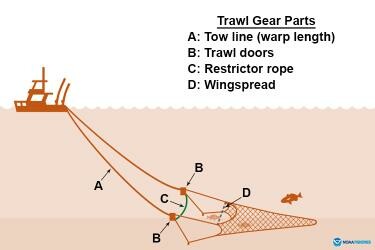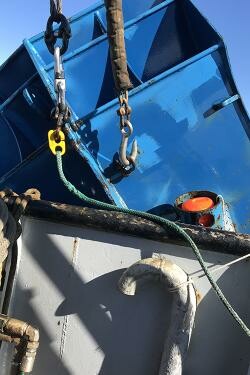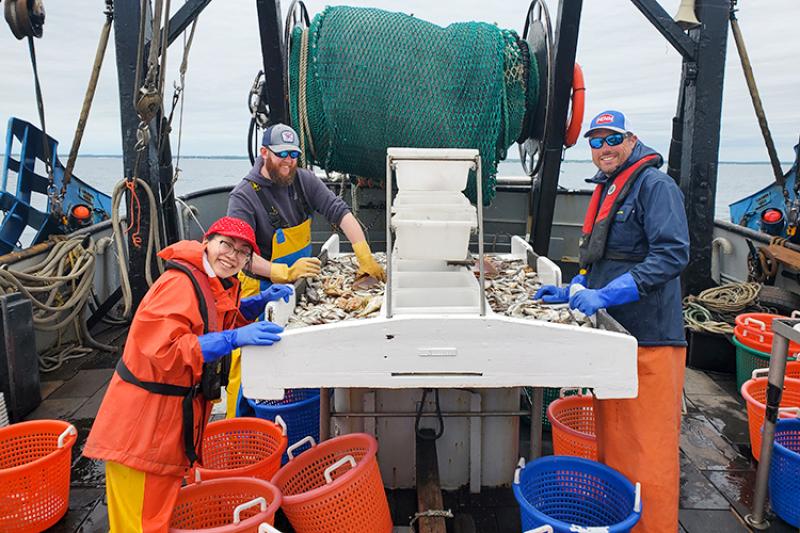Scientists and fishermen have worked together over many years to develop bottom trawl survey gear that performs consistently, ensuring accurate and reliable data for U.S. fisheries management.
This summer they have been evaluating a potential way to better standardize survey gear – a ‘restrictor rope’ that helps keep the distance between trawl doors consistent while trawling in different conditions, depths, warp lengths, and gear configurations.
A summary of the project from the National Marine Fisheries Service’s Northeast Fisheries Science Center describes experiments in spring and summer 2022 at sea with scientists and fishermen with long experience in cooperative survey work.
Their main platform was the F/V Darana R, with Captain Jimmy Ruhle, his son Bobby Ruhle and their crew. Homeported at Wanchese, N.C., the Darana R has for years supported the bi-annual Northeast Area Monitoring and Assessment Program bottom trawl survey, led by the Virginia Institute of Marine Science at Gloucester Point, Va.
The NEAMAP program facilitates the collection of fishery-independent information in the Northeast, and standardizes survey procedures to improve data quality and accessibility.
Expanding offshore wind energy development off southern New England will force changes on bottom trawl surveys in just the next few years. The Vineyard Wind, South Fork Wind and Revolution Wind turbine arrays will be built between Martha’s Vineyard and Long Island’s East End.
“Existing surveys will need to adapt to operate in and around offshore wind farm areas,” according to the Northeast Fisheries Science Center. “Researchers will also need to develop new surveys to fill data gaps created when pre-existing survey locations can’t be accessed. A standardized gear configuration will need to be used so data collected during existing and new surveys can be used, and compared.”
For help with that redesign, the science center went to the Northeast Trawl Advisory Panel, a joint advisory panel composed of Mid-Atlantic and New England Fishery Management Council members, as well as fishing industry, academic, government and non-government fisheries experts. It identified the use of a restrictor rope as a possible way to standardize all Northeast bottom trawl surveys in the region. None have used restrictor ropes yet.

Restrictor ropes may provide better consistency in how survey nets perform, the science center explained:
“Many factors can affect how a trawl net fishes in the water, including water depth, tides and currents, boat speed, and warp length (the amount of tow cable let out). These can influence how far the heavy doors on a trawl spread, which can change the shape of the net opening. For example, when the doors spread wide, the net opening can be flattened like a pancake. When they’re not spread as wide, the opening takes on a more oval shape.”
“Restrictor ropes have the possibility of reducing one of the most variable parts of trawl gear geometry – door spread,” said scientist Mike Pol, a member of the trawl advisory panel and research director at the Responsible Offshore Science Alliance.
“Preventing the doors from spreading helps avoid overspreading the net, and can help maintain a constant net shape and reduce variation in catchability," said Pol. "Variation in area swept is also reduced, helping make indices from trawl surveys more accurate.”
Scientists use area swept values to calculate and standardize catch. This means the catch in one location can be compared to catches in other locations.
In June scientists from the Northeast fisheries center worked with the Ruhles and their crew on the Darana R, and scientists at the Virginia Institute of Marine Science to begin the restrictor rope study.
Teaming up with the NEAMAP veterans for the restrictor rope research “is ideal, as they have long-standing expertise with trawl survey gear as well as a skilled crew to execute the work,” said Anna Mercer, chief of the Northeast Fisheries Science Center’s Cooperative Research Branch, and a member of the trawl advisory panel.
Dustin Gregg, the VIMS chief of trawl survey operations, is optimistic about the study.
“Survey data quality is inexorably linked to the performance of the sampling gear. Given the interest in adopting this gear package for a variety of new research endeavors, it’s my hope that this study will allow the restrictor modification to help achieve cross-platform data uniformity in the future,” said Gregg.

The first set of study experiments started on May 30 in Rhode Island and on Block Island Sound off the state’s coast. Over the course of eight days, the team conducted a total of 80 bottom trawl tows – 40 with the restrictor rope and 40 without. During the restrictor rope tows, each end of a 7/16-inch high strength/low stretch single braid polyester Tenex rope was attached to the bottom trawl doors using Viking hooks. The team collected a variety of data, including:
- Catch: Fish species, counts, lengths, total weight by species
- Hydrographic: Water temperature, salinity, dissolved oxygen
- Atmospheric: Air temperature, wind speed and direction, barometric pressure, sea state, general weather
- Tow: GPS location, direction, tow speed, tow depth, net geometry, warp length
Some of the species they caught during the experiment included Atlantic cod, black sea bass, butterfish, longfin squid, northern sea robin, scup, silver hake, spotted hake, striped bass, summer flounder, white hake, and winter flounder.
“Since species composition differs by season, the team will continue this research in the fall. In the coming months, Institute scientists, with support from our fishery scientists, will analyze the data and present their research findings to the Panel in early 2023,” according to the science center.
Kathryn Ford, trawl panel lead for the science center, said she is enthusiastic about the continued collaboration.
“There are legitimate concerns about how to standardize the collection of trawl survey data to be able to integrate multiple sources of data and to understand the impacts of offshore wind on our fisheries resources. The panel has long focused its attention on research survey performance, and this study represents the first in which we are examining how to best standardize survey gear deployed from commercial vessels.”







